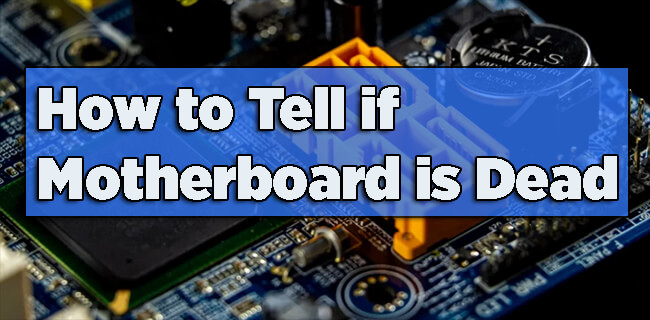The motherboard, the computer’s central hub, plays a vital role in its operation. When it malfunctions, it can disrupt the entire system. In this guide, we’ll uncover the signs of a dead motherboard, methods to check its power status, and potential revival solutions. By the end, you’ll be equipped to diagnose and address motherboard issues effectively.

How to Tell if a Motherboard is Dead –
1. No Power Signs:
Check No lights or sounds: If, upon pressing the power button, you observe the absence of LED lights, spinning fans, or any other discernible signs of activity, this strongly suggests that your motherboard could be non-functional.
No POST (Power-On Self-Test): When your computer fails to complete the POST process, which is the initial hardware check, and doesn’t show any output on the screen, it’s a possible indication that the motherboard might be responsible for the issue.
2. Beep Codes:
Some motherboards produce beep codes that indicate specific hardware problems during the POST. Consult your motherboard’s manual to decipher these codes.
3. Visual Inspection:
Look for physical damage on the motherboard, such as burnt areas, damaged capacitors, or loose components. Any visible damage can be a sign of a dead motherboard.
4. Diagnostic Tools:
Use diagnostic tools like a POST card or motherboard testing kit to identify hardware issues. These tools can provide detailed information about the motherboard’s condition.
How to Check if the Motherboard is Receiving Power –
Follow these steps:
1. Power Supply Check:
Ensure that the power supply unit (PSU) is functioning correctly. You can use a PSU tester or swap in a known working PSU to eliminate power supply issues.
2. Power Connectors:
Verify that all power connectors, including the 24-pin ATX and 4/8-pin CPU power connectors, are securely plugged into the motherboard.
3. Wall Outlet & Power Cord:
Check the wall outlet and power cord for any faults. Plug in another device to confirm that the outlet is providing power.
4. Motherboard Indicator Lights:
Some motherboards have indicator lights that show if they are receiving power. Consult your motherboard’s manual to find these LEDs and their meanings.
How to Potentially Fix a Dead Motherboard –
If you suspect your motherboard is dead, here are some steps you can take to potentially revive it:
1. Check for Loose Connections:
Ensure that all components, such as RAM, graphics card, and CPU, are properly seated in their respective slots.
2. Clear CMOS:
Reset the motherboard’s CMOS settings by either using a jumper or removing the CMOS battery for a few minutes. This can sometimes resolve boot issues caused by corrupted BIOS settings.
3. Test with Minimal Hardware:
Disconnect all non-essential components (extra RAM, drives, peripherals) and try booting with only the CPU, one stick of RAM, and the power supply connected.
4. Inspect for Short Circuits:
Ensure that no metal objects or loose screws are causing a short circuit on the motherboard by touching metal contacts.
5. Update BIOS:
Should your motherboard possess a removable BIOS chip, there is the potential to substitute it with an updated version. Nevertheless, it is essential to note that this is an intricate procedure that demands careful execution.
In the End, Diagnosing a dead motherboard requires patience and a systematic approach. When faced with a non-responsive computer, consider the absence of signs of life, the results of a POST test, and the motherboard’s physical condition. Moreover, check power connections and use diagnostic tools if necessary.
While some issues can be resolved through troubleshooting and minor adjustments, a dead motherboard may ultimately necessitate professional intervention or replacement. Armed with the knowledge and techniques provided in this guide, you can make informed decisions and effectively address motherboard-related problems, ensuring your computer runs smoothly once more. So, now you are able to understand and How to Tell if Motherboard is Dead?
Read: How to Clean the Motherboard [Ultimate Guide]
Common Questions About Dead Motherboards:
1. Will a Dead Motherboard Light Up?
Answer: Not necessarily. Some motherboards have indicator lights, but a dead motherboard may not show any signs of life.
2. Motherboard Died Suddenly?
Answer: Motherboards can fail suddenly due to various factors, including power surges, overheating, or component wear and tear.
3. Motherboard Dead on Arrival (DOA)?
Answer: If you suspect a new motherboard is DOA, consult the manufacturer’s warranty and return policy. They will typically replace or repair it if it’s within warranty.
